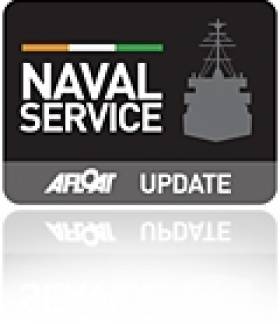Displaying items by tag: LE Eithne Rufugee Role
#EithneMedCrisis – It has been confirmed LÉ Eithne (P31) is to depart Cork Harbour this morning on a humanitarian mission to the Mediterranean as previously reported on Afloat.ie following discussions held between Irish and Italian authorities, writes Jehan Ashmore.
The deployment of the 1,800 tonnes 'flagship' is for a period of six months by the Minister of Defence Simon Coveney T.D. was recently given approval by Government. Joining the Minister this morning in the Naval Base Haulbowline, Cork Harbour was An Taoiseach Enda Kenny T.D. who met the crew before the HPV vessel departs for the Mediterranean.
At the ceremony, the Minister stated that "The humanitarian crisis in the Mediterranean is of great concern to Ireland. The quick response by the Irish Government in deciding to despatch a Naval Vessel highlights our commitment to assist with efforts to prevent further tragedy and loss of life at sea."
The Minister further stated that "The despatch of an Irish naval vessel represents a tangible and valuable Irish national contribution to assisting the Italian authorities in the humanitarian search and rescue operation."
A crew of 68 personnel from the Permanent Defence Force and 2 medical staff from the Army Medical Corps will assist Italian authorities in the carrying out of humanitarian search and rescue of refugees subject to the operational demands and requirements.
It is understood this is the first time in almost 60 years that an Naval Service vessel is to be deployed for humanitarian purposes.
The Minister concluded by saying "I wish to commend the Defence Forces on their efficient operational and logistical planning for this deployment. I want to wish each and every crew member of L.É. Eithne, under the command of Commander Pearse O'Donnell, a safe and successful mission. You will be in our thoughts throughout the duration of your tour of duty."
The 31 year-old L.E.Eithne was launched in 1984 as a Helicopter Patrol Vessel (HPV) which used to carry a 'Dauphin' helicopter on the extensive aft- deck. Next to the aft-deck is an adjoining hanger which will further assist in her new role in the rescue of refugees.
Note to the left of the twin funnels (abreast) with the hanger area below is a RIB and associated derrick (click photo from previous report) which was not part of the original ship when completed by Verolme Cork Dockyard. It is understood this RIB that rests on a cradle structure brings to three RIB craft onboard.
As the numbers of fleeing migrant refugees rises from war-torn regions in the Middle East and throughout northern swathes of the African continent, the EU has stepped up its efforts to assist authorities.
Among the nations already involved are the UK which has its 'flagship' HMS Bulwark carrying out rescue of refuges using the amphibious vessels fleet of landing craft.





























































